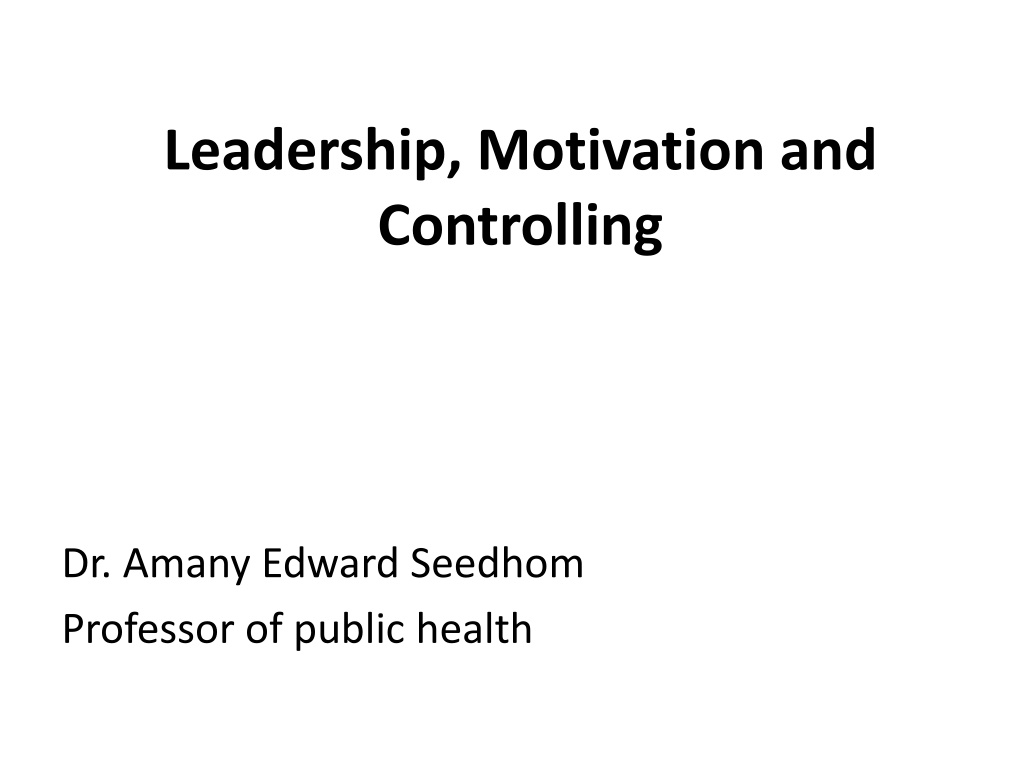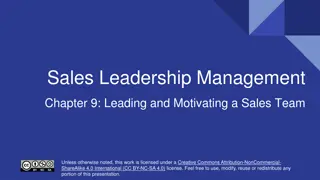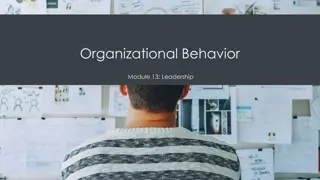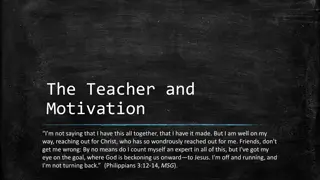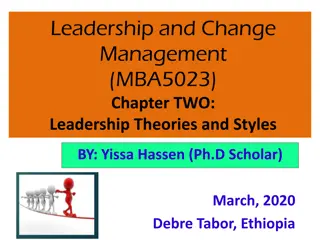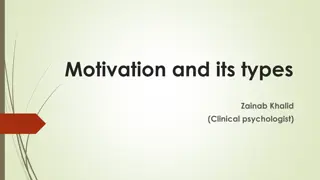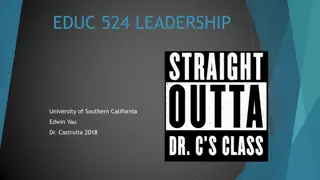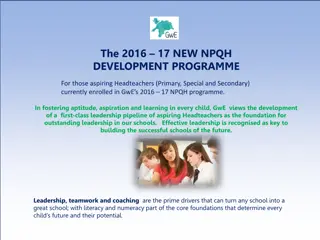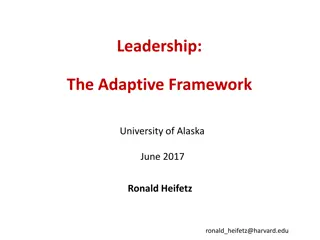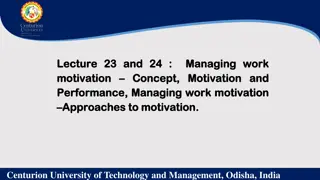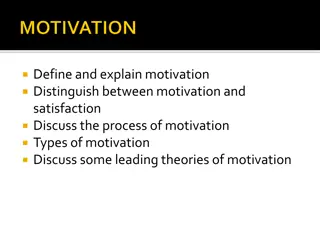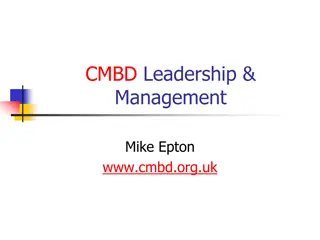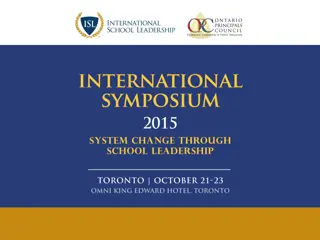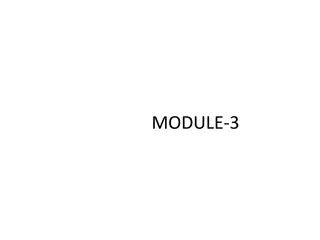Leadership, Motivation and Controlling
Leadership is a process of bringing people together to achieve organizational goals, involving directing, influencing, and motivating employees. Explore leadership styles, such as autocratic leadership, and the managerial grid's five styles. Understand the differences between managers and leaders, their focus, and objectives. Learn about the importance of balancing task completion and employee needs in effective leadership.
Download Presentation

Please find below an Image/Link to download the presentation.
The content on the website is provided AS IS for your information and personal use only. It may not be sold, licensed, or shared on other websites without obtaining consent from the author.If you encounter any issues during the download, it is possible that the publisher has removed the file from their server.
You are allowed to download the files provided on this website for personal or commercial use, subject to the condition that they are used lawfully. All files are the property of their respective owners.
The content on the website is provided AS IS for your information and personal use only. It may not be sold, licensed, or shared on other websites without obtaining consent from the author.
E N D
Presentation Transcript
Leadership, Motivation and Controlling Dr. Amany Edward Seedhom Professor of public health
Leadership Leadership is a process focused on bringing people together to accomplish a goal set for the organization at the highest level of excellence. It involves directing, influencing and motivating employees essential to perform tasks
Leader Manager Focuses on the future Establishes vision and direction Focus on goals Makes change Inspire- Motivate- Influence Leader does the right things Focuses on the present Focus on tasks/process Achieves balance Plan- Organize- Coordinate Manager does the things right
The five leadership styles of the managerial grid The followers/group members way a leader typically behaves towards his Includes: 1- It is characterized by low concern for both people and production. The primary objective of style is for managers to stay out 2- Country club: It is characterized as a high concern for people low concern for production. The primary objective is to create a secure and comfortable atmosphere and trust that subordinates will Impoverished: (stay out of trouble ) of trouble . and a respond positively.
3- Produce or perish: A high concern for production and a low concern for people characterize it . The primary objective is to achieve the organization's goals. It is not necessary to consider employees' needs as relevant 4- Middle of- the road: A balance between workers' needs and the organization's productivity goals characterize it . The primary objective is to maintain employee morale at a level sufficient to get the organization's work done. 5- Team : It is characterized by a high concern for both people and production . The primary objective is to establish cohesion and foster a feeling of commitment among workers
DIFFERENT LEADERSHIP MODELS: a. Autocratic leadership involves making managerial decisions consulting other, and implies power over others. without Characteristics include: - The leader makes the decision - Little input from others - Autocratic leadership involves absolute, authoritarian control over a group. - Members of the group are rarely trusted with important tasks or decision
Advantages Decisions are made speedily Useful where decision is unfavorable. Useful in cases where followers are incompetent. Disadvantages Has negative effect on group morale decisions may not be supported. - Can create yes mentality among group members
b. Participative or democratic leadership consists of managers and employees working together to make decisions. Characteristics include: - Group members are encouraged to share ideas and input; the leader frequently makes the decision. - Individuals feel more involved in the group process. - Creativity is encouraged and rewarded.
Advantages increased members. support for final decision. better decisions shared Disadvantages Slower decision. Diluted accountability for decisions. Possible designed to morale of through ideas. compromises please all
c. Laissez faire or free-rein leadership involves leader exercises very little control or influence over group members. Characteristics include: - Involves employees being relatively free to do whatever it takes to accomplish those objectives - Role of leader managers setting objective and is facilitative
Advantages Disadvantages Lack of group cohesion and unity toward org. goals. Lack of direction control. Inefficiency Increased opportunity for individual development. All persons are given a chance themselves independently. and to and express function and chaos
The trait approach: Set of characteristics were identified to assist in selecting the right people to become leaders. 1- Physical traits include being young to middle-aged, energetic, tall, and handsome. 2- Social background being educated at the '' right" schools and being socially prominent or upwardly mobile. Social characteristics include being charismatic, charming , tactful , popular , cooperative , and diplomatic . 3- Personality traits include being self-confident , adaptable , assertive , and emotionally stable . 4- Task-related characteristics include being driven to excel , accepting of responsibility , having initiative , and being results-oriented
Motivation Definition: It is the set of processes that moves a person towards a goal. It is used to describe the forces within the individual that account for the level, direction, and persistence of effort expended at work.
A REWARD is a work outcome of positive value to the EXTRINSIC REWARDS administered (e.g., INTRINSIC REWARDS are self-administered as the feelings of - Both Intrinsic and Extrinsic rewards can help the individual. externally praise). are pay and personal development manager to achieve maximum motivational impact.
Maslow's Hierarchy of Needs Maslow wanted to understand what motivates people. Maslow (1943) stated that people are motivated to achieve certain needs. When one need is fulfilled a person seeks to fulfill the next one, and so on. The earliest and most widespread version of Maslow's (1943, 1954) hierarchy of needs includes five motivational needs, often depicted within a pyramid
This five stage model can be divided into basic needs (e.g. physiological, safety, love, and esteem) and growth needs (self actualization). One must satisfy lower level basic needs before progressing on to meet higher level growth needs.
Controlling Definition: Controlling is an evaluation of how well an organization has achieved its goals and to take any corrective actions needed to maintain or improve performance. The outcome of the control process is the ability to measure performance accurately and regulate organizational efficiency and effectiveness
Steps of control process 1. Establish performance standards 2. Measuring actual current performance 3. Comparing actual performance against a standard 4. Taking corrective action if necessary
There are two types of standards: Output Standards: measure performance results in terms of quantity, quality, cost, or time. Input Standards: measure work efforts that go into a performance task. (measure resources)
The comparison of actual performance with desired performance establishes the need for action. Ways of making such comparisons include: Historical / Relative / Engineering Benchmarking Benchmark: the standard of excellence against which to measure and compare. Used to compare your own organizational performance against that of other organizations considered to have "best practices".
Importance of controlling 1- Ensures effective and efficient utilization of organizational resources so as to achieve the planned goals 2- Provide information employee performance. 3- Minimize workplace determine future actions to take. 4- Helps maintain compliance with essential organizational rules and feedback on disruptions and and policies.
Types of control Preliminary control - Feed-forward control - Accomplished before a work activity begins -They make sure that proper directions are set and that the right resources are available
Concurrent control Steering control Focus on what happens during the work process. They monitor ongoing activities to make sure that things are being done correctly. operations and
Post-action control Feedback control They focus on end results. Take place after an action is completed.
Managers can rely on people to exercise self- control (internal) over their own behavior. Alternatively, managers can take direct action (external) to control the behavior of others.
